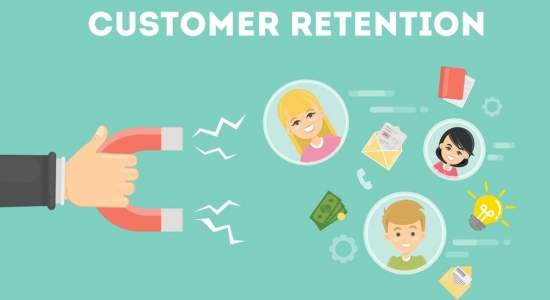- Resources
- Your Step-by-step Guide to Better Customer Retention
Your Step-by-step Guide to Better Customer Retention

While every penny your company makes is hard-earned, the source of that money is worth working even harder for. Customers are the lifeblood of all businesses, both online and in the physical world.
It should come as no surprise that customer retention, or keeping customers coming back for more, is one of the most important business strategies companies use today. Knowing how to increase customer retention and develop long-term relationships with them is key to any organization’s success.
Here we’ll take a look at what customer retention is, why it matters, and what strategies you can use to build better customer relationships.
In this article, we will explore:
What Is Customer Retention?
Customer retention is a business concept that focuses on how customer relationships are established and maintained over time. It is a process of developing loyalty and long-term engagement between customers and companies. The goal of customer retention is to reduce customer churn, meaning existing customers stick around longer and continue purchasing goods or services. It helps create a lasting relationship with customers, which can lead to higher customer lifetime value (CLV).
Why Is Customer Retention Important?
It’s simple economics—acquiring a new customer costs five times more than keeping an existing one. A successful customer retention strategy can have far-reaching benefits for any business. Not only does it create loyal customers who are likely to buy more from you in the future, it can also save you the money and resources that would be spent on constantly acquiring new customers.
Bain & Company reports that as little as a five percent increase in customer retention has the potential to increase profits up to 95 percent.
How Is Customer Retention Measured?
In mathematical terms, customer retention rate is the percentage of customers who give a company consistent business over a set period of time. It’s calculated by subtracting the number of customers at the end of a given time period by the number of new customers added during that same time, dividing by the number of customers at the beginning, and multiplying by 100.
Written out as a formula, this looks like the following.
((A – B) / C) * 100 = Retention Rate
A: Number of customers at the end of the time period
B: Number of new customers added during the time period
C: Number of customers at the beginning of the time period
For example, let’s say a business starts January off with 100 customers. During the month, they acquire 25 new customers and end with 115 total.
The customer retention rate for January would be calculated as follows:
((115 – 25) / 100) x 100 = 90%.
This means that 90% of the customers were retained over the course of January.
The Importance of Consistent Data
Of course, it’s important to realize that the number-crunching process isn’t always that straightforward. One common area of confusion for business owners is what defines a ‘customer’, as this will affect the accuracy of your customer retention rate calculation. For instance, do you include customers who only made a one-off purchase during the time period in question? What about those who have been inactive for some time but haven’t explicitly canceled their subscription?
Whichever route you decide to go, make sure that the data plugged into the equation is consistent and from the same source. Failing to do so could skew the results and lead you to make decisions based on inaccurate information.
Key Customer Retention Metrics

The mathematical formula provided above isn’t your only option when it comes to gauging customer satisfaction levels. Some companies make a point of informing their strategies with additional metrics that might reflect how happy people are with their products or services. Used in combination with a hard retention rate, this information can give you invaluable insight into how clients feel about their current relationship with your business.
Here’s a list of metrics that you might use in tandem with retention rate calculations to better understand your customer base:
Net Promoter Score (NPS)
How likely are customers to recommend your product or service? That’s exactly what a New Promoter Score, or NPS, is supposed to determine. Typically, customers are asked to rate their likelihood of recommending your services on a scale from 0–10. Anything above 7 is considered good and anything below 4 is considered bad.
Churn Rate
While it isn’t applicable to all products, churn rate is definitely worth calculating if you have insight into how often customers renew their subscriptions or make additional purchases. The metric represents the number of people who cancel their subscriptions or stop using a product within a given period of time. Churn rate is basically the opposite of retention rate – you’re calculating who’s leaving instead of who is staying.
Customer Lifetime Value (CLV)
This is an often overlooked metric that can be incredibly useful for understanding what kind of investments you should make into customer acquisition. A CLV calculation will help you understand how much revenue a single customer is likely to bring in over their lifespan with your company, as well as bring urgency to the need to retain them. How much are you losing if they leave?
Customer Satisfaction Score (CSAT)
Customer Satisfaction Score (CSAT) reflects how likely people are to recommend your product or service by rating their satisfaction on a scale from 0–10. This score can give you valuable insight into how customers feel about the product or service they are currently using. Take a look at the top CSAT software.
Customer Effort Score (CES)
Customer Effort Score (CES) evaluates how much work people have to put in to get what they want from you. It helps measure customer satisfaction and loyalty – both of which are key determinants of retention.
What’s a Good Customer Retention Rate?
The answer to this question really depends on the type of business you have, your target customers, and their needs. Generally, a good customer retention rate is considered to be around 60 to 80 percent meaning that for every 100 customers that purchase from your company, 60 to 80 of them will continue to purchase and remain loyal customers over time.
It’s worth noting that customer retention rates can vary depending on the industry you’re in and the type of product or service you offer. For example, a subscription-based business might have a higher customer retention rate than that of an ecommerce store since customers are more likely to stick around through recurring bills.
12 Customer Retention Strategies to Use for Your Business
Customer retention strategies can vary depending on the company, its size, its customer base, and what types of products or services it offers. But with that being said, there are definitely some tried and true best practices that anyone can benefit from learning. We go over 10 of the best tips and strategies for bolstering customer retention in the section below.
1. Personalize As Much As Possible
Ask any well-informed marketer today and they’ll tell you that the consensus is clear: personalization stands to be one of the most effective strategies for increasing customer retention over the coming decades. In a world where consumers have grown weary of run-of-the-mill ads, speaking directly to people is the only chance you have of capturing and keeping their attention. This goes beyond the initial sales journey to post-purchase; marketing communications like newsletters, emails, and even social media posts can all be made more effective with personalization.
How you tailor interactions to individual customers can depend on a few factors, like the size of your business and how much information you have about each customer. But even if your resources are slim, you should still strive for as much personalization as possible.
Sephora offers a great example of how powerful tailored experiences can be when done right. The beauty giant has amassed a large base of loyal shoppers through its comprehensive profiles, quizzes, and recommendations. These allow shoppers to save product favorites, get personalized beauty tips and advice from Sephora experts, or even find out about different products through virtual try-on features.
2. Deeply Understanding Customer Needs
Collecting feedback from customers is an effective way to improve customer retention. By gathering feedback, businesses can identify areas of improvement and make changes to their products or services accordingly. Surveys and social media monitoring are two popular methods for collecting feedback. By implementing customer feedback, businesses can improve customer satisfaction and loyalty, which in turn can lead to increased revenue and growth.
Online grocery brand BigBasket nurtures customer loyalty by gaining a deep understanding of their needs. They employ various methods, including customer service data analysis, surveys, and feedback to drive decision-making, ensuring the company stays aligned with customer needs. By delving into customer feedback, addressing product concerns, and observing online behavior, they gain insight into their thought process and behavior.
3. Reducing the Need for Customer Service
A key focus for customer service should be to reduce the need for customer service. Customer reaches you primarily for two reasons- If there is not enough information or there is some error- item missing, delayed order, undesirable quality, or more. You need to go above and beyond to meet the needs of your customers and ensure that they are satisfied with your products or services.
One of India’s leading insuretech firms, Acko, utilizes Ozonetel CCaaS to achieve customer service excellence. Through a smart IVR solution, the team anticipates the purpose of incoming calls, allowing customers to efficiently address requests such as policy endorsements, changes, and renewals without agent assistance. Integration with Freshdesk equips agents with contextual information, leading to quicker responses and an enhanced customer experience.
4. Invest In Your Existing Customer Base
To expand on point number one, the way you interact with customers after they buy should be just as thoughtful as the way you interact with them afterward. Whether they end up happy with the purchase or not, reputations are never set in stone. All too often, companies fail to recognize this and focus solely on getting more leads.
The truth is that investing in a strong customer base is just as important, if not more so. Loyal customers will bring in repeat business, help generate referrals for future prospects, and recommend your product to friends and family.
What does investing in existing customers look like? Remembering their name, preferences, and purchase history is just the start. Communication should be ongoing and consistent; there’s nothing worse than spending lots of money on a product to feel as if that’s all the business cared about. It’s important to continue cultivating relationships through follow-ups, surveys, and newsletters. It’s also essential to encourage feedback and make sure customers know that they are being heard and taken into account.
Bon Appetit’s newsletter is a great example of how to engage existing customers. The company sends out weekly emails that include recipes, food news, and other content related to their brand. Investing in existing customers helps to create a memorable experience that will keep them coming back for more, ultimately leading to increased loyalty and revenue growth.
5. Offer Relevant Deals
Consumers love to feel like they’re getting a great deal, arguably more so when they’ve received a personalized experience. Offering customers relevant deals and discounts is an excellent way to show them you value their business, as well as encourage loyalty. It further gives them a reason to choose your company the next time they need the same product or service – why go somewhere else when you have a great deal from a company with which you’ve already established a relationship?
There’s a shortage of companies that use this strategy to keep customers engaged. Just think about how many times you’ve received a coupon from a company you’ve previously shopped with. Target, for example, regularly sends out emails featuring deals on items people have purchased in the past, or similar ones that may be of interest to them.
6. Try Member-Exclusive Discounts, Offers, and Perks
To extend on the previous point once again, there’s something special to be said about giving people member-exclusive discounts. It’s a way to demonstrate that you value your customer base and want them to stick around for the long haul. These exclusive discounts could include:
- Early access to sales events
- Discounts on certain products or services
- Free gifts or rewards for loyalty
- Access to exclusive events
- Discounts on merchandise available only to members
Amazon Prime effectively invented subscription-based loyalty programs, and they have since become an essential part of the modern customer experience.
7. Deploy Artificial Intelligence
As technology continues to progress and evolve, so too will the opportunities for enhancing customer interactions. With advancements like artificial intelligence (AI), machine learning, natural language processing (NLP), and facial recognition, opportunities to create tailored experiences for customers become even more limitless.
AI-powered chatbots are already being used to automate customer service inquiries, reducing wait times and improving resolution rates. AI can also be used to personalize and customize a customer’s experience on an eCommerce website, helping them find the perfect products or services for their needs.
The ‘Macy’s on Call’ smartphone-based assistant is a great example of AI being used to improve the customer experience. This AI-powered assistant helps customers find products in stores by using natural language processing technology.
8. Provide Omnichannel Support
It’s one thing to have the intention of serving customers’ needs at all times and another to actually do so. People use all sorts of devices and platforms to interact with brands nowadays, so the best way to make sure that you aren’t missing out on opportunities is by providing omnichannel customer service. Consider setting up a live chat feature on your website, having dedicated phone lines for customers, and implementing automated SMS support for urgent needs.
Emerging health tech firm Healthians use Ozonetel’s unified CX platform to provide seamless diagnostic experience to patients across channels. Patients could book appointments, access reports, and receive medical advice — not only through the app, website, and email — but also via WhatsApp and phone calls.
9. Use Automation to Your Advantage
Modern technology has allowed us to automate more processes than ever before. Why not take advantage? Automated customer service notifications, personalized emails, and follow-up messages can all be created with minimal effort. These automated systems will help you stay in touch with customers on a regular basis without having to manually reach out each time—which is especially helpful if you’re managing a large customer base. You can also use automation to collect data about your customers that will be invaluable in helping you create more targeted content and campaigns in the future.
India’s top gold loan NBFC, Muthoot Fincorp, adopted an automated approach to send out payment reminders to their customers. They leveraged Ozonetel’s voice bot technology to make over 8,700 automated collection calls. This also saved their agents’ bandwidth, which could be reassigned to other roles, optimizing workforce utilization.
10. Launch a Loyalty Program
Long-term relationships with customers certainly benefit your business – but what about the customers themselves? Ultra-competitive markets prove there’s no such thing as easy customer loyalty. It goes beyond simply providing people with what they’ve been promised to offer something back. Usually, that ‘something back’ is a loyalty program.
A well-designed loyalty program can reward customers for their purchases and encourage them to come back for more. Aside from discounts, you may consider giving away free samples or hosting exclusive events for loyal shoppers.
Well-established businesses with loyalty programs include Walgreens, Sephora, and Amazon. They reward their customers with points for purchases or actions that can later be redeemed for discounts or exclusive products.
11. Segment Your Retention Rate
Let’s bring the focus back to retention metrics by exploring how breaking the data down by segment can offer some insight.
Some business leaders choose to make multiple retention rate calculations, categorizing how well they’re holding onto different categories of customers. With that strategy, it becomes easier to gauge the types of people your company is making good impressions on and identify the ones who need more attention.
For example, a company that caters to individual consumers may want to track customer retention rate separately for its personal and corporate customers. In this case, the business would find out if it’s better at keeping private individuals or businesses as long-term customers.
12. Use Customer-Friendly Tools
At the end of the day, the best way to increase customer retention rate is by providing an enjoyable experience that meets the needs of your customers.
To do so, you must ensure there are tools and systems in place that make it easy for your clients to interact with you. This could be a web-based platform, mobile app, or chatbot.
No matter which you choose, make sure it is user-friendly and intuitive. Customer service inquiries should always be answered promptly and courteously, no matter the platform.
In Conclusion
Customer retention is a crucial aspect of any business. It goes beyond mere transactions and focuses on building lasting relationships with customers. By providing exceptional experiences, addressing concerns promptly, and leveraging valuable feedback, businesses can create a loyal customer base. This loyalty translates into repeat business, positive word-of-mouth, and increased profitability.
At Ozonetel, we understand that customers are at the heart of every successful business and strive to provide our clients with the best customer experience tools in the market. By implementing our solutions, businesses can improve customer satisfaction and loyalty, which in turn can lead to increased revenue and growth. Reach out to Ozonetel today to learn more about our solutions.
Want to see what Ozonetel can do for your company? Sign up today for a free 21-day trial.
Frequently Asked Questions
Customer retention involves Onboarding, Engagement, Loyalty, and Advocacy. These stages focus on welcoming customers, fostering engagement, building loyalty, and turning satisfied customers into advocates for the brand.
The key to customer retention lies in delivering exceptional customer experiences, addressing concerns promptly, and building lasting relationships based on trust and value. It is crucial for a business to anticipate customer needs and also understand what’s causing customers to churn and then employ strategies to build a loyal group of buyers who will buy more often and make bigger purchases.
An example of customer retention is a loyalty program where customers earn rewards for repeat purchases, encouraging them to stay loyal to a brand.
The purpose of retention is to keep existing customers and continue to generate revenue from them. Customer retention allows a business to maintain and strengthen the relationship with its customers, ensuring continued satisfaction and loyalty.
Customer retention is crucial for businesses because it drives repeat purchases and ongoing value from the customer base. Retaining customers successfully leads to increased profitability, positive word-of-mouth, and sustained success by retaining existing customers.
Customer retention is often prioritized over acquisition because it costs less to retain an existing customer than to acquire a new one. Moreover, existing customers are more likely to make repeat purchases and promote the product.
Customer retention can be challenging due to changing customer preferences, increased competition, and evolving market dynamics, requiring businesses to adapt and innovate.
Key Performance Indicators (KPIs) for customer retention include customer churn rate, customer lifetime value, and Net Promoter Score (NPS), measuring customer satisfaction and loyalty.
To analyze customer retention, businesses can calculate churn rates, analyze customer feedback, monitor engagement metrics, and evaluate the success of retention strategies.
Yes, customer retention is measurable through various metrics, including repeat purchase rates, customer satisfaction scores, and other key performance indicators that quantify the effectiveness of retention efforts.
Prashanth Kancherla
Chief Operating Officer, Ozonetel Communications
Over the past decade, Prashanth has worked with 3000+ customer experience and contact center leaders...
Chief Operating Officer, Ozonetel Communications
Over the past decade, Prashanth has worked with 3000+ customer experience and contact center leaders to comprehensively understand the need for effective and efficient customer communications at every step of their journey with a brand. Deeply embedded in today’s CCaaS ecosystem, he has been instrumental in Ozonetel's growth and contributed in various roles including product management, sales, and solution architecture.







